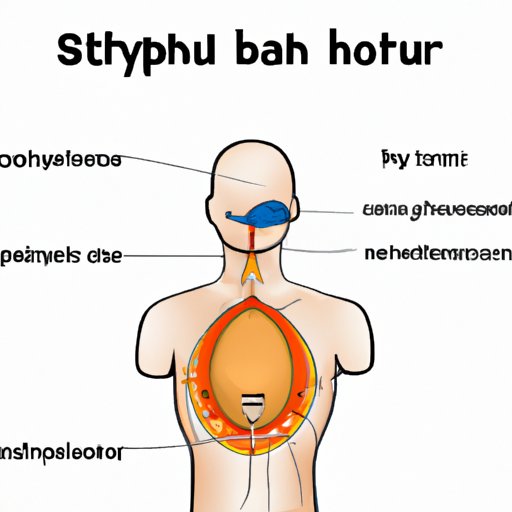Introduction
The diaphragm is a dome-shaped muscle located at the base of the thoracic cavity. It plays an essential role in breathing, as well as in speech production, core strength, and posture. In this article, we will explore the anatomy and physiology of the diaphragm, its function in respiration and speech production, and how it can be used for core strength and posture.

Exploring the Anatomy and Physiology of the Diaphragm
The diaphragm is located at the base of the thoracic cavity, just below the lungs. It is composed of two leaflets: a central tendon and three muscular slips that attach to the sternum, ribs, and spine. The diaphragm is innervated by the phrenic nerve, which originates in the neck and supplies motor and sensory information to the muscle. It is also supplied with blood from the inferior phrenic arteries.

Function of the Diaphragm in Breathing
The diaphragm plays an important role in breathing. During inhalation, the diaphragm contracts and flattens, increasing the volume of the thoracic cavity. This pressure change creates a vacuum within the chest, drawing air into the lungs. During exhalation, the diaphragm relaxes and returns to its resting position, decreasing the volume of the thoracic cavity and forcing air out of the lungs.
How the Diaphragm Contributes to Respiration
The diaphragm contributes to respiration by creating pressure changes within the thoracic cavity. During inhalation, the diaphragm contracts and flattens, resulting in a decrease in intra-thoracic pressure. This decrease in pressure creates a vacuum-like effect, drawing air into the lungs. During exhalation, the diaphragm relaxes and returns to its resting position, increasing intra-thoracic pressure and forcing air out of the lungs. This cycle of contraction and relaxation is repeated with each breath.

The Role of the Diaphragm in Speech Production
The diaphragm plays an important role in speech production. According to research published in the journal Voice, “the diaphragm is the primary driving force for vocalization” (Voice, 2018). By controlling the pressure within the thoracic cavity, the diaphragm helps to control pitch and tone. In addition, it helps to regulate airflow during inhalation and exhalation, allowing for proper articulation of sounds.
What Happens When the Diaphragm is Weakened?
When the diaphragm is weakened, it can lead to a variety of symptoms, including shortness of breath, fatigue, and difficulty speaking. Common causes of diaphragmatic weakness include injury, illness, or chronic conditions such as COPD. Treatment options may include physical therapy, medications, or surgical intervention. In some cases, strengthening exercises may be recommended to help strengthen the diaphragm.
Using the Diaphragm for Core Strength and Posture
The diaphragm plays an important role in core strength and posture. Strengthening the diaphragm can help improve posture and reduce back pain. Exercises that target the diaphragm can include abdominal bracing, planks, and side planks. These exercises can help strengthen the diaphragm and improve overall core strength.
Conclusion
The diaphragm is a crucial element of the human body, playing an important role in respiration, speech production, core strength, and posture. It is located at the base of the thoracic cavity and is responsible for creating pressure changes within the chest, which allows for inhalation and exhalation. Additionally, the diaphragm plays a critical role in vocalization, helping to control pitch and tone. When the diaphragm is weakened, it can lead to a variety of symptoms, including shortness of breath, fatigue, and difficulty speaking. Fortunately, there are several treatment options available, including physical therapy, medications, and strengthening exercises. If you think you may have a weak diaphragm, talk to your doctor about possible treatments.
This article has explored the anatomy and function of the diaphragm, its role in respiration, speech production, and core strength. We have also discussed the symptoms of a weak diaphragm and the treatment options available. Understanding the importance of the diaphragm and how to maintain its strength can help keep your body healthy and functioning properly.
(Note: Is this article not meeting your expectations? Do you have knowledge or insights to share? Unlock new opportunities and expand your reach by joining our authors team. Click Registration to join us and share your expertise with our readers.)
